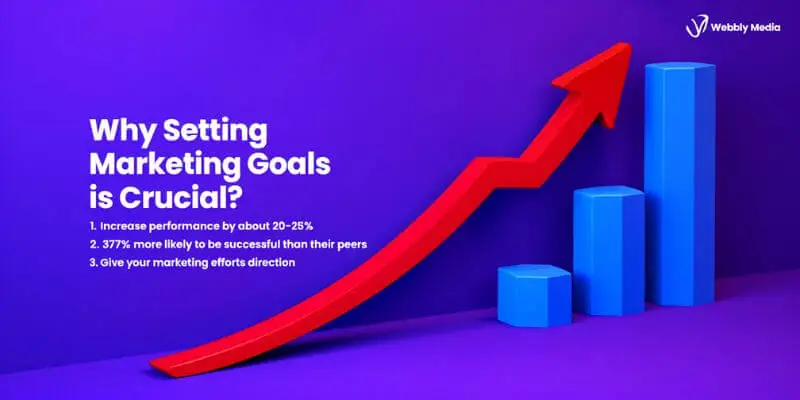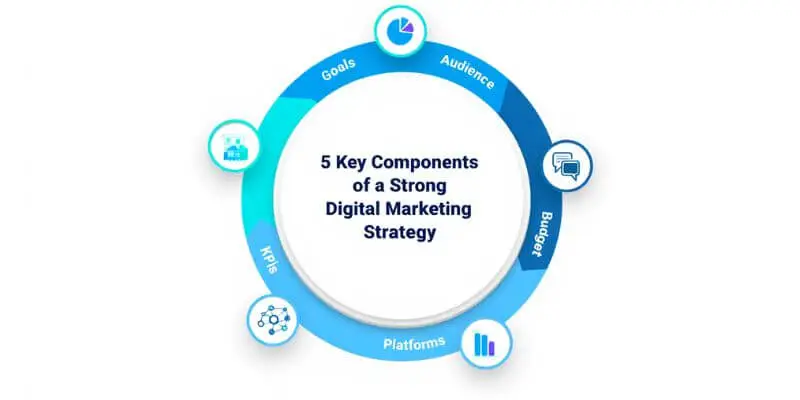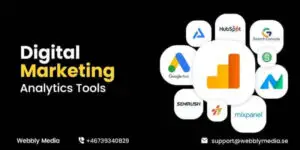In today’s competitive market, a strong digital marketing strategy is the foundation of every successful online business. It acts as a clear roadmap that keeps your marketing efforts focused and effective.
A well-structured marketing plan connects your brand’s vision with specific goals that drive measurable growth. Moreover, it saves time, reduces guesswork, and helps you make smarter decisions with real data.
At Webbly Media, we, as a digital agency, have helped over 1,000 businesses in the past 7 years. During this time, we have seen many startups grow into full-fledged brands through the right marketing strategy and plan.
In this blog, we will discuss the right marketing strategies, their importance, and how to set your marketing goals step by step for 2025. So, let’s get started!
What is Digital Marketing Strategy?
A digital marketing strategy is a plan that shows how a business will use online platforms to meet its marketing goals. It explains what you want to achieve and how you will get there using different digital channels like a website, social media, SEO, or paid ads.
Many people mix up a marketing strategy with a marketing plan or campaign. But they are not the same. A strategy defines your overall vision, while a marketing plan details the specific methods, channels, and timelines you will use to achieve that vision. Meanwhile, a campaign is a short-term effort aimed at achieving a specific goal. So, the strategy is your foundation, the plan is your roadmap, and the campaign is your action step.
A common misconception is that strategy and tactics are the same. But in reality, strategy refers to your long-term vision, and tactics are the specific steps to achieve it. Without a strong strategy, even the best tactics may fail to produce consistent results.
Why Setting Marketing Goals is Crucial?

Marketing goal setting is essential for a successful online marketing strategy. According to Gitnux’s “Goal-setting statistics,” having a clear marketing goal in general can increase performance by about 20-25%. Another report published by CoSchedule found that those who set clear and measurable marketing goals are 377% more likely to be successful than their peers.
Goals give your marketing efforts direction, helping you focus on what matters and track your progress. This is why we advise businesses to start with a strong goal.
To make your goals effective, use the strategic marketing framework “SMART.” This means your goals should be Specific, Measurable, Achievable, Relevant, and Time-bound. For instance, you can frame goals like increasing brand awareness, generating qualified leads, or improving customer retention as SMART goals.
Clear goals help you track key performance indicators (KPIs), measure return on investment (ROI), and evaluate how well you are doing. In short, strong goals turn your marketing strategy into a system that promotes measurable growth.
How a Clear Strategy Makes Your Digital Marketing Activities Easy
A clear digital marketing strategy provides a simple plan for your business. It outlines the tasks you should complete first and those that come next, making your marketing efforts easier to manage. When you know your goals and which channels to focus on, your digital marketing activities will be more effective.
Additionally, a clear strategy helps you use your time and budget wisely. You can invest in resources that give you the best return on investment and easily track your performance as every action aligns with your goals. In short, a well-defined strategy transforms scattered marketing efforts into a focused, goal-oriented approach.
Key Components of a Strong Digital Marketing Strategy

A strong digital marketing strategy relies on five key components. These elements guide your decisions and help you measure growth effectively. Here’s a look at them:
✅ Goals
Clear marketing goals define what success looks like and help your team stay focused. These objectives make it easier to prioritize actions and track progress throughout your campaigns.
✅ Audience
Understanding your audience’s needs, behaviors, and preferences ensures your message reaches the right people. This knowledge helps you create content that connects with them.
✅ Budget
A well-planned budget allows you to use your resources efficiently. This is to make sure every marketing dollar is spent on channels and strategies that give the best ROI.
✅ Platforms
The platforms you select affect your visibility and engagement. There are too many platforms to choose from. Each offers different ways to reach your audience effectively.
✅ KPIs
Key Performance Indicators (KPIs) help to track your progress. Metrics like traffic, conversions, and engagement show what is working. They allow you to refine and improve your strategy over time.
How To Create a Digital Marketing Strategy
To create a successful digital marketing strategy, you need to plan carefully and execute wisely. Here are the key steps to develop a clear marketing plan for 2025.
1. Set Your Business Goals & Objectives
As we said before, every successful online marketing strategy starts with setting clear business goals and objectives. Before you plan campaigns or create content, you must understand what you truly want to achieve. Your goals should align with your larger business vision.
To make your goals actionable, follow the SMART criteria. Keep them Specific, Measurable, Achievable, Relevant, and Time-bound. This method helps turn vague ideas into practical targets that your team can track.
👉 Example:
✔️ Goal: Increase brand visibility in the local market.
✔️ Strategy: Use SEO and social media campaigns to reach new audiences.
✔️ Objective: Boost website traffic by 30% and gain 500 new qualified leads in three months.
By setting clear goals, you lay a strong foundation for all your marketing decisions.
2. Identify Your Target Audience
To make your digital marketing efforts more effective, you need to know who you are trying to reach. When you understand your audience well, your messages become more personal, relevant, and engaging.
Start by looking at your audience data. Then, create detailed buyer personas that represent your ideal customers. Each persona should include key details like:
✔️ Demographics: Age, gender, location, and job.
✔️ Psychographics: Interests, values, lifestyle, and reasons for buying.
✔️ Pain Points: Problems they want to solve and how your product can help.
✔️ Online Behavior: Which platforms they use the most and how they consume content.
You can also get feedback through surveys, polls, or interviews to make your personas more accurate. By identifying your target audience clearly, you can customize your content and campaigns to reach the right people at the right time and on the right channel.
3. Analyze Your Market & Competitors
To create a successful digital marketing strategy, you need to understand your market. This involves knowing how demand is changing and what your competitors are doing to attract customers. A strong analysis helps you find opportunities, spot competitors’ gaps, and avoid mistakes.
Start by doing market research and competitor analysis so that your decisions are based on facts:
✔️ Study Market Trends: Look at current industry changes, new technologies, and shifting consumer habits.
✔️ Know Your Competitors: Identify your top 5–10 competitors and analyze their websites, social media, and advertising strategies.
✔️ Compare Strengths & Weaknesses: Find out what they do well and where they lack.
✔️ Understand Customer Expectations: Check reviews, forums, and social media to see what customers like or dislike.
✔️ Use Tools & Data: Use platforms like Ahrefs, SEMrush, SimilarWeb, or Google Trends to find keyword rankings, traffic data, and audience sources.
By merging market insights with competitor information, you can identify gaps that your brand can fill. This clarity sharpens your marketing strategy and helps you stand out in a crowded digital market.
4. Identify Gaps Compared To Competitors
Once you identify your competitors, the next step is to evaluate your brand. Find out where you are lacking compared to them. Recognizing your gaps and weaknesses helps you make smart improvements rather than guessing what needs fixing. It’s not about copying your competitors; it’s about figuring out how you can provide something unique.
Here’s how to find those gaps:
✔️ Analyze Performance Metrics: Compare your website traffic, conversions, and engagement rates to the average in your industry.
✔️Review Your Content & SEO: Look for topics or keywords that your competitors cover that you don’t.
✔️ Evaluate Customer Experience: Check reviews or feedback to see where customers have trouble with your product or service.
✔️ Audit Your Brand Presence: Examine how consistent your design is, how clear your messaging is, and how your brand tone compares to others.
By identifying these gaps, you can focus on improvements that truly matter. This will help you refine your strategy, improve user experience, and strengthen your market position.
5. Choose The Right Marketing Channels
After setting your goals and knowing your audience, it’s time to choose how to reach them. Selecting the right digital marketing channels helps you target the places where your customers spend their time. Instead of trying to be everywhere, focus on the platforms that give the best return and engagement for your business.
Follow these steps to choose the right channels:
✔️ Know Your Audience Behaviour: Find out which platforms your audience uses the most.
✔️ Balance Free and Paid Efforts: Combine free methods (like SEO, blogs, and social media posts) with paid ads for faster results. You can use SEO and content marketing for long-term growth, PPC for quick visibility, and social media for brand awareness.
✔️ Track Channel Performance: Use tools to see which channels work best.
By choosing and improving the right mix of digital channels, you can make your marketing strategy clearer and more effective to achieve results.
6. Create a Content Plan and Calendar
A clear content plan and calendar keep your marketing organized and consistent. They tell you what to post, when to post, and where to post. This way, your audience always gets fresh and relevant content. Without a plan, marketing can become random and ineffective.
To create a good plan:
✔️ Define Content Types: Use blogs, videos, reels, infographics, newsletters, and more.
✔️ Map Content to Buyer Journey: Focus on the awareness, consideration, and decision stages.
✔️ Maintain a Schedule: Use tools like Notion, Trello, or Google Sheets to plan your content weekly or monthly.
✔️ Repurpose and Reuse: Turn one topic into different formats, like changing a blog into a carousel or email.
A clear content calendar helps you stay consistent, save time, and ensure each post supports your marketing goals.
7. Create Your Marketing Message And Value Proposition
Your marketing message explains why your audience should care about you, while your value proposition shows why they should choose you. Together, these create the emotional and logical base of your digital marketing strategy.
Here’s how to create a strong message:
✔️ Focus on Benefits, Not Just Features: Explain how your service solves real problems.
✔️ Be Clear and Human: Use simple language, speak like your customer.
✔️Highlight Your Unique Value: Show what makes your brand different.
✔️Stay Consistent Across Channels: Use the same tone and core promise on your website, ads, and social media.
A strong value proposition builds trust, strengthens brand identity, and encourages more meaningful engagement.
8. Set Your Budget And Resources
No matter how creative your strategy is, to make your strategy successful, you need a realistic budget and resource plan. A budget helps you control costs, spend money wisely, and track your ROI without overspending.
Here are some key points to consider:
✔️ Allocate by Channel: Split your budget based on the expected ROI. For example, SEO gives long-term benefits, while ads usually bring quick results.
✔️ Include Tools and Software: Remember to add costs for digital analytics tools, automation software, and resources to create content.
✔️ Consider Human Resources: Think about how many team members you need, if you want to hire freelancers, or if you would prefer an agency.
✔️ Allow for Flexibility: Set aside a small part of your budget for new ideas or unexpected trends.
A clear financial plan makes your marketing effective, ensuring every dollar contributes to your growth.
9. Track And Optimize Your Marketing Strategy
The final step in a solid digital marketing strategy is marketing performance tracking and improving your campaigns. After you launch your campaigns, watch how they perform to find out what works and what doesn’t.
To stay on track:
✔️ Set clear goals: Focus on key metrics like traffic growth, conversion rates, or lead costs.
✔️ Use analytics tools: Use tools like Google Analytics, Search Console, or Meta Ads Manager for real-time insights.
✔️ Test and improve: Run A/B tests to refine your headlines, visuals, and audience targeting.
✔️ Review regularly: Check your performance every month or quarter to adjust your strategy as needed.
What Are The Most Effective Marketing Channels in 2025?

Digital marketing success relies on picking the right combination of channels to boost reach, engagement, and conversion. Here are some effective platforms to consider:
✅ Search Engine Optimization (SEO)
Search engine optimization (SEO) is the process of optimizing your website to appear in search engine results pages (SERPs). This ensures your content reaches the right audiences organically.
➤ How it supports strategy: It builds your brand’s long-term visibility and brings in traffic at a lower cost.
✅ Social Media Marketing (SMM)
Social Media Marketing helps promote your brand on platforms like Facebook, Instagram, LinkedIn, and TikTok. It is great for building brand awareness.
➤ How it supports strategy: It connects you with your audience and keeps them engaged through creative content and paid ads.
✅ Google Ads/PPC (Pay-per-click)
Google Ads, also known as Pay-Per-Click (PPC), is a way to advertise your business that places your ad at the top of search results. You only pay when someone clicks on your ad.
➤ How it supports your strategy: It helps you get quick visibility, attracts people, and fast conversions.
✅ Email Marketing
Email marketing is the process of sending personalized messages directly to your subscribers’ inboxes. It is excellent for retention and sales.
➤ How it supports strategy: It helps keep your audience engaged, boosts conversions, and encourages repeat purchases.
✅ Video Marketing
Video marketing uses visual storytelling on platforms like YouTube, Instagram Reels, and TikTok to promote your brand or products.
➤ How it supports strategy: Videos grab attention quickly and explain complex ideas in an engaging way. This builds trust and increases engagement.
Latest Trends of The Digital Marketing Landscape
The digital marketing landscape is changing quickly because of new technologies and consumer behaviour. In 2025, some effective strategies are leading the way. Here’s a look at them:
✅ Influencer Marketing
Brands are working with influencers to create authentic content that builds trust. Micro and nano influencers connect better with specific communities.
✅ Artificial Intelligence and Automation
AI is transforming marketing by automating repetitive tasks, analyzing large data sets, and personalizing user experiences. Tools like predictive analytics and smart ad targeting make marketing more efficient.
✅ Chatbots and Live Chats
Chatbots and live chat systems provide instant customer support 24/7. It improves user satisfaction, speeds up response times, and helps businesses capture leads through real-time conversations.
✅ Voice Search SEO
As more people use smart speakers and mobile assistants, voice SEO is now a hot marketing strategy in 2025.
✅ Data Privacy Marketing
As consumers become more aware of how their data is used, brands need to be transparent about their data practices. Respecting privacy and building trust are now essential for marketing success.
✅ AR/VR Marketing
Augmented Reality (AR) and Virtual Reality (VR) are changing how brands interact with customers. Immersive product demos and virtual try-ons help customers connect with brands emotionally.
✅ Earned Media:
Earned media is when people talk about your brand for free, like when they mention it, share it, or write reviews. It shows others that your brand is good and makes people trust it more.
Webbly Media Can Help You With Digital Marketing

Webbly Media is a trusted digital marketing agency in Sweden. We help businesses grow their online presence, attract the right customers, and increase sales with tailored digital marketing strategies. We serve clients across the country, including Stockholm, Uppsala, Malmö, Gothenburg, and Örebro.
➤ Why Choose Us:
- 7+ years of proven experience
- 5-star digital marketing services
- 24/7 online support, serving nationwide
- Affordable and transparent pricing
- Customer-friendly behavior
- 100% Satisfaction Guarantee
Check us out on Google and contact us today to solve your marketing challenges.
Frequently Asked Questions
Yes, small businesses can gain from a digital marketing roadmap. A strong plan helps them get noticed, attract the right customers, and compete with larger brands affordably.
The time varies by strategy and platform. SEO can take 3 to 6 months to show results. Pay-per-click (PPC) ads can generate immediate traffic, while social media builds trust over time with consistent effort.
The budget depends on your goals, the channels you choose, and your business size. It’s important to invest in SEO, ads, content, and tools to track growth and ensure a good ROI.
You can measure effectiveness with key performance indicators (KPIs) like website traffic, conversions, engagement rate, click-through rates, and ROI.
This decision depends on your resources, skills, and goals. Usually, agencies provide more expert help, flexibility, and strategy than an in-house team.
Mobile optimization is essential to ensure that websites and content work well on all devices. It enhances user experience, engagement, conversion rates, and search engine rankings.
A solid digital marketing strategy should regularly analyze data, audience behavior, and industry trends. This helps brands adjust their campaigns to keep up with the fast-changing digital landscape.








